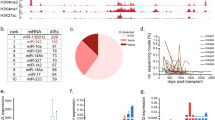Abstract
The vascular endothelial growth factor receptor 3 (VEGFR-3/FLT4) is a receptor tyrosine kinase that regulates angiogenesis and vasculogenesis in response to the binding of the ligands VEGF-C and VEGF-D. Mutations in VEGFR-3 have been identified in patients with primary lymphoedema. It has been noted previously that whilst in the mouse there is only a single Vegfr-3 transcript, in humans there are two transcripts of 5.8 and 4.5 kb, of which the shorter encodes a protein that lacks the C-terminal 65 amino acids. These two isoforms also differ in their biological activity. Analysis of the human VEGFR-3 cDNA and genomic sequence reveals that these two isoforms arise by alternative splicing of the terminal exons. The shorter transcript is generated by splicing into the long terminal repeat of a human endogenous retrovirus located between the last two exons, thus explaining the lack of the shorter transcript in the mouse. The retention of the retroviral sequences in the FLT4 locus suggests that this retrotransposition event has contributed significant additional function to this gene. This provides support for a role for integrated retroviruses in modulating gene activity and participating in evolutionary processes.
Similar content being viewed by others
Author information
Authors and Affiliations
Additional information
Received: 5 December 2000 / Accepted: 26 February 2001
Rights and permissions
About this article
Cite this article
Hughes, D. Alternative Splicing of the Human VEGFGR-3/FLT4 Gene as a Consequence of an Integrated Human Endogenous Retrovirus. J Mol Evol 53, 77–79 (2001). https://doi.org/10.1007/s002390010195
Published:
Issue Date:
DOI: https://doi.org/10.1007/s002390010195




